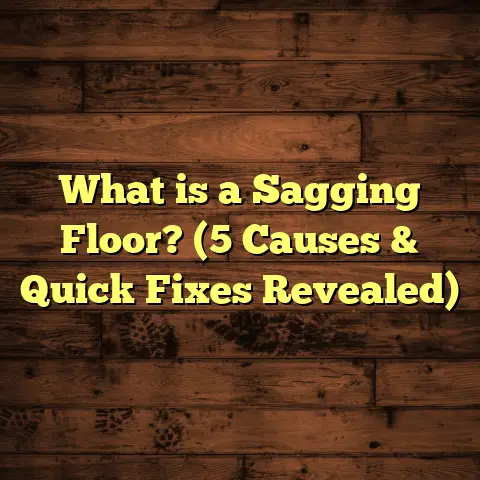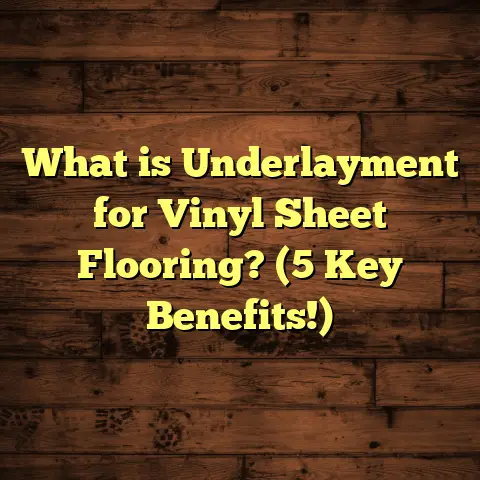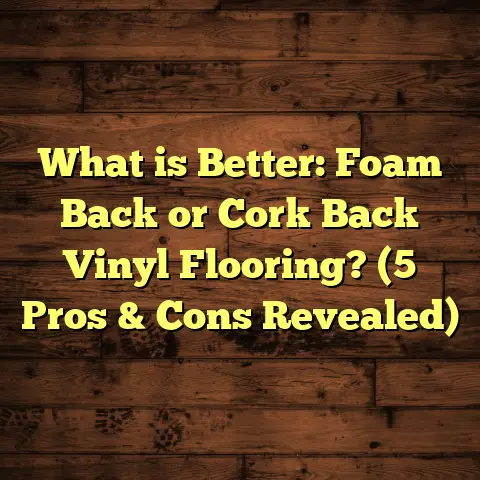What is Floor Installation Price? (5 Key Factors Revealed!)
Spring is just around the corner, and you might be thinking about freshening up your home. If you’re like me, the thought of new flooring often pops up as a way to transform a space without a complete remodel. But how much does it actually cost to install new floors? Is it out of reach, or can you find options that fit your budget? Over the years, I’ve worked on countless flooring projects, and I’ve learned that understanding the price behind floor installation is key to making smart choices.
What Is Floor Installation Price?
Floor installation price is basically the total amount you pay to have new flooring put down in your home or business. It includes several components like the cost of materials, labor, preparation work, and sometimes extras like removal of old flooring or special finishes. When someone asks me, “How much will it cost?” I always explain that this price isn’t just about the wood or tile itself—it’s about everything involved in getting those floors ready to walk on.
Think of it as the cost of not just buying the flooring but also paying for the skill and time needed to make it look great and last long. Sometimes people focus only on the price of the flooring planks or tiles they see in stores, but the installation price is what really impacts the final bill.
Over time, I’ve noticed that many homeowners underestimate this cost by a big margin. For example, during a recent project, a client bought high-end hardwood thinking their total expense would be around $4,000 for 500 square feet. But after installation, their bill was closer to $7,000 once labor and prep were included. That’s why knowing what goes into the installation price is so helpful.
Now, let’s break down the five key factors that play a major role in determining your floor installation price.
1. Type of Flooring Material
This one’s huge. The kind of flooring you choose affects both material costs and installation complexity.
Hardwood Flooring
Hardwood has been my personal favorite to work with for years—it’s classic, durable, and adds real value to any home. But it’s also one of the more expensive options.
Material costs for hardwood range from $6 to $15 per square foot depending on wood species (oak tends to be mid-range; exotic woods like Brazilian cherry are pricier). Installation usually requires professional skill since hardwood needs proper acclimation to your home’s climate before laying. It involves nailing or gluing each plank down carefully.
From my experience, hardwood installation time is longer: expect about 2-3 days for an average 500 sq ft room. This drives labor costs higher.
One memorable project involved installing white oak flooring in an open concept living/dining area totaling 700 sq ft. The client chose a custom stain and matte finish. The material cost was about $9 per sq ft; labor ran close to $7 per sq ft because we had to remove old carpet first and sand the floor afterward for a flawless finish. The total cost was roughly $11,200 but worth it for the stunning transformation.
Laminate Flooring
Laminate is often called “budget hardwood” but don’t mistake it for cheap quality. It offers decent durability and comes in tons of styles.
Material prices hover between $2 and $5 per square foot. Installation is simpler because laminate usually clicks together without nails or glue.
I once helped a friend install laminate in their basement—about 400 sq ft—and we finished in just one weekend. Labor costs were lower since we did all the work ourselves, saving about $1,600 compared to hiring professionals.
But laminate can’t be refinished like hardwood and may show wear faster—something to think about if you want longevity.
Vinyl Flooring
Vinyl has become extremely popular lately, especially luxury vinyl plank (LVP) and tile (LVT) options that mimic wood or stone beautifully.
Material costs range widely—from $1.50 per sq ft for basic vinyl sheets to $7 or more for premium LVT.
Installation is usually straightforward; many vinyl products use adhesive backing or click-lock systems. However, subfloor prep is crucial for vinyl—any bumps show through.
In one project, I installed LVP in a kitchen remodel spanning 300 sq ft. Total costs came in around $4,500 including materials and labor—about $15 per sq ft—but durability and waterproof qualities made it worth it for my client who had kids and pets.
Tile Flooring
Tile is another popular choice for kitchens, bathrooms, and entryways because it’s hardwearing and water-resistant.
Material prices vary—ceramic tile can be as low as $3 per sq ft while porcelain or natural stone tiles often run $7 to $15 or more.
Installation is labor-intensive: cutting tiles precisely, setting mortar, grouting, sealing. Expect professional labor rates around $5 to $10 per sq ft.
I recall a bathroom tile project where the client wanted intricate mosaic patterns around the shower niche. This added hours of labor and pushed total costs to over $25 per sq ft installed—but the result was stunning and unique.
Carpet
Carpet remains an affordable option with material costs from $1 to $5 per sq ft depending on fiber type.
Installation includes padding and stretching carpet into place. Labor is generally moderate—about $1.50 to $3 per sq ft.
For bedrooms or low-traffic areas, carpet offers warmth but doesn’t last as long as hard surfaces.
2. Size and Shape of the Area
How big is the space? That’s simple but important.
The larger the area, generally, the lower the price per square foot because installers can work more efficiently without moving equipment as much. For example:
| Area Size | Average Cost per Sq Ft (Material + Installation) |
|---|---|
| Under 200 sq ft | $8 – $12 |
| 200-500 sq ft | $6 – $10 |
| Over 500 sq ft | $5 – $9 |
Oddly shaped rooms or spaces with lots of corners add complexity. I once installed tile flooring in a room with many angles and built-in cabinets; it took much longer to cut and fit pieces perfectly, pushing labor costs up by 20%.
Another example comes from an older home with small rooms connected by narrow hallways. Installing hardwood throughout required extra care to transition between different room levels and deal with varying subfloor heights. This added roughly 15% more labor than a straightforward rectangular layout.
3. Labor Costs
Labor can be 40% to 60% of your total floor installation price.
Rates vary by location and installer experience. In urban areas or places with a higher cost of living, labor rates are naturally higher. From my experience on jobs in New York City versus smaller towns in the Midwest, labor costs can shift from $3 per square foot to over $8.
Some installers charge flat rates per room; others charge by the hour. On average, expect to pay between $1.50 and $5 per square foot for labor.
I remember one job where the homeowner was very hands-on but didn’t have experience with tile installation. They tried doing part of it themselves but ended up having me come back for corrections—their mistakes ended up costing more in time and material waste than paying for professional installation upfront would have.
If you’re considering DIY installation to save money, weigh your skills carefully against potential risks like uneven floors or poor adhesion which could shorten lifespan and increase replacement frequency.
4. Preparation Work
This factor often surprises people.
Before installing new floors, there might be removal of old flooring, leveling of subfloors, moisture barriers installed, or fixing structural issues.
For example:
- Removing old flooring: Carpet removal costs about $1-$2/sq ft; tile removal can climb above $3/sq ft due to difficulty.
- Subfloor leveling: Uneven surfaces require grinding or patching; expect around $1-$3/sq ft.
- Moisture barriers: Essential for basements or areas prone to dampness; adds roughly $0.50-$1/sq ft.
- Repairs: Fixing rot or damaged joists can add thousands depending on severity.
I recently worked on a basement project where moisture barriers were necessary before installing vinyl planks. Skipping this step would have led to warping within months. The added prep cost was around $800 for 600 sq ft but saved headaches later.
5. Additional Features and Finishes
Sometimes you want something extra: radiant heating under your floors, special stains or sealants on hardwood, or intricate tile patterns.
These add-ons increase both material and labor costs.
- Radiant Heating: Installing underfloor heating can add $6-$15/sq ft installed.
- Custom Stains & Finishes: Hardwood floors can be stained in various shades; custom finishes add about 10-20% more.
- Intricate Tile Patterns: Mosaic designs or borders increase installation time by 15-30%.
- Soundproofing Layers: Adding underlayment for sound control adds costs but improves comfort.
- Protective Coatings: Waterproof sealants or UV-resistant finishes help extend floor life at extra cost.
I shared a story earlier about a white oak floor with a custom stain—it was memorable because the client wanted a color not typically available off-the-shelf. Achieving that took extra prep time and testing samples before committing to full staining.
Real Numbers from My Projects
I like sharing actual examples because they give a clearer picture than general estimates.
Here’s a quick breakdown from three recent projects I handled:
| Project | Size (sq ft) | Material | Total Cost | Cost per Sq Ft |
|---|---|---|---|---|
| Kitchen Remodel | 250 | Luxury Vinyl | $3,500 | $14 |
| Living Room & Hallway | 600 | Hardwood | $9,000 | $15 |
| Basement Renovation | 400 | Laminate | $2,400 | $6 |
Notice how hardwood stands out as more expensive even though it’s not the largest space.
In another detailed case study from my records:
A family wanted eco-friendly bamboo flooring throughout their main level (about 850 sq ft). Bamboo material cost was moderate at around $4 per sq ft but installation was tricky due to uneven subfloor in some areas requiring extra leveling work ($1/sq ft). Labor was higher because installers had to acclimate bamboo carefully over several days before nailing down. Total project cost ended up being near $11,000 ($12.94/sq ft), which was above average but justified by eco benefits and durability.
How Does Floor Installation Price Compare to Other Home Improvement Costs?
You might wonder how floor installation stacks up against other upgrades like painting walls or kitchen cabinets.
Painting walls averages about $1.50 to $3 per square foot including labor.
Kitchen cabinet refacing runs around $4,000 for an average kitchen—which might be comparable but less visible than new floors.
Flooring tends to be one of the more expensive but impactful changes you can make. When done right, it improves aesthetics and durability for years.
Here’s a quick comparison chart based on typical home improvement projects:
| Project | Average Cost Range | Impact on Home Value |
|---|---|---|
| Floor Installation | $5 – $15 per sq ft | High |
| Painting | $1.50 – $3 per sq ft | Moderate |
| Kitchen Cabinet Refacing | Around $4,000 total | Moderate |
| Bathroom Remodel | $10,000 – $25,000 total | High |
Flooring often offers one of the best returns on investment when selling your home alongside kitchen and bathroom upgrades.
Wrapping Up with a Look at Alternatives
If you’re thinking about new floors but worried about cost, you have options:
- DIY Installation: Some flooring types like vinyl planks or laminate are DIY-friendly and save on labor costs. But mistakes here can be costly later.
- Refinishing Existing Floors: Instead of replacement, sanding and refinishing hardwood floors can cost around $3 to $5 per square foot and extend life.
- Peel-and-Stick Vinyl Tiles: Budget-friendly and easy to install but less durable long term.
- Area Rugs: Not a floor upgrade but adds warmth and style without major expense.
- Engineered Wood: Offers hardwood look at lower price points with easier installation than solid wood.
- Cork Flooring: Comfortable underfoot with moderate price range ($3-$8/sq ft).
From my experience, investing in quality materials plus professional installation usually offers the best return in comfort and home value. But if budget limits you, combining smaller upgrades with smart choices can still refresh your space nicely.
My Takeaway Tips From Years Installing Floors
After working on dozens of projects across different homes and budgets, here are some things I always share with clients:
- Get multiple quotes: Prices vary widely by installer so shop around.
- Don’t skip prep: Proper subfloor work prevents headaches later.
- Consider lifespan: Cheaper floors may save now but cost more over time.
- Ask about warranties: Especially on materials like vinyl or laminate.
- Think resale value: Hardwood usually pays off if you plan to sell.
- Factor in downtime: Some installations take days; plan accordingly.
- Plan for waste: Usually order 5-10% extra material for cuts and mistakes.
- Choose finishes wisely: Matte vs glossy looks impact appearance heavily.
- Ask about eco options: Bamboo or cork may align with sustainability goals.
- Communicate clearly: Make sure installer knows your expectations upfront.
Final Thoughts
Understanding floor installation price involves more than just looking at sticker tags on material boxes—it’s about knowing the whole picture: materials, size, labor, prep work, and extras all add up.
If you’re planning flooring changes soon, take time to research your options carefully based on your budget and lifestyle needs. Whether you want luxury hardwood or budget-friendly vinyl planks installed yourself, knowing these factors will help you avoid surprises and get results you’ll love walking on every day.
Got questions about specific materials or need help estimating costs? Feel free to ask—I’m always happy to share what I’ve learned firsthand from years of hands-on experience!





